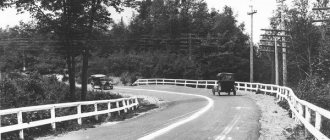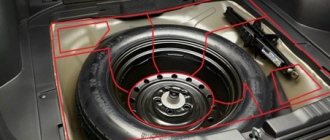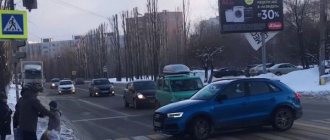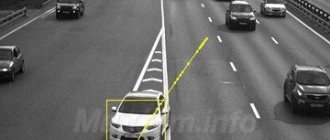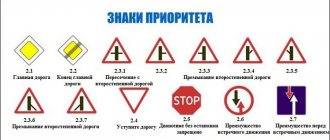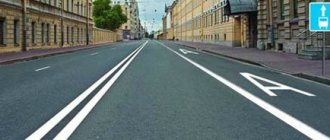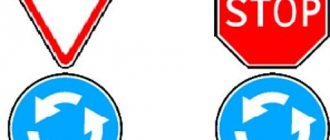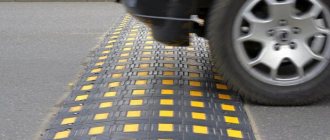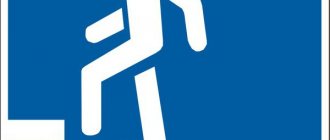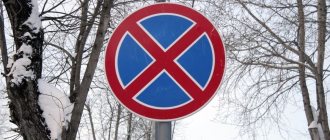Any marking is an important warning element on the road, along with signs and traffic lights. According to the traffic rules, priority is given to horizontal temporary markings. It is applied to the roadway and often causes problems: they may forget to remove it or apply it incorrectly, creating contradictions with the accompanying designations. For crossing temporary markings, fines range from 500 to 5000 rubles.. Pernicious violators are even deprived of their rights for a whole year.
The article describes all the features of using temporary markings and provides fines for each violation associated with crossing them. Drivers will learn when and where markings are applied and what their main difference is from permanent ones. The most interesting questions from readers on the topic are discussed separately.
Types of temporary road markings
There are two types of road markings (traffic regulations, Appendix No. 2):
- Vertical.
- Horizontal.
The latter is presented in the form of lines, arrows, inscriptions and other symbols on the road surface. It is needed in order to establish the mode and order of traffic on the road or to reflect other important information.
Horizontal can be:
- Permanent - applied in one place and acts on an ongoing basis; It comes in white and yellow (1.4; 1.10; 1.17; 1.26).
- Temporary - used only for a while, most often in connection with repair work or replacement of the road surface, the duration of which is more than three days (GOST R 51256-1999).
It is usually highlighted in orange and can be used together with the permanent one. Sometimes yellow or red are used. For application, only materials are taken that allow quick removal, if necessary.
Its task is to warn drivers about the presence of a dangerous situation, changes in traffic flow, temporary changes in rules (it is forbidden to overtake, change lanes, stop, etc.).
The rules do not stipulate what markings can become temporary.
Temporary can also replace permanent yellow. For example, if, due to repair work and narrowing of the road, it is necessary to establish a ban on stopping or it should be temporarily moved further or closer.
Priority level
In accordance with the current traffic rules, the highest level of priority in our case is a portable road sign. It is the easiest to install and dismantle if necessary. Therefore, there is simply no alternative to its use in the event of an accident or short-term repair work.
Next in the hierarchy, one step lower, is a stationary road sign. It is more important for regulating the movement of vehicles in relation to the markings (especially in cases where they are no longer visible on the road surface). This results in a higher priority level.
Road signs are a higher priority than road markings
Temporary road markings are even lower in importance. It is applied for a short period of time, for example, while a road is being repaired. It is quite problematic to meet it on domestic roads and highways. It is used extremely rarely and in very extreme cases. Therefore, when the driver sees such a drawing, he is very surprised. Some drivers may become confused and create an emergency situation on the road.
Last, fourth on the list is permanent road markings. It is applied in a thick layer of paint and it is almost impossible to remove it from the road surface. It must be constantly present on the road surface and facilitate the safe and fast movement of vehicles in a given area.
Based on the above, the priority of road markings is as follows:
Road signs:
- Temporary
- Permanent
Road markings:
- Temporary
- Constant
Based on the above hierarchy, it is quite easy to understand any traffic situation, no matter how complex it may be.
Where and in what cases is it applied?
Temporary markings are used on roadways where there is an improved surface to organize the movement of traffic during work that lasts more than three days (GOST R 51256-1999).
It is applied in accordance with GOST R 52289-2004 in certain areas:
- to ensure the removal and stabilize the deviation of traffic along the lane width in the direction of changing the vehicle’s trajectory;
- to determine the buffer area and designate the work site in places bordering the lanes along which traffic moves.
The temporary one should be applied next to the permanent one when they coincide.
If markings are added to the roadway, which should divert the traffic flow, it is compared with the installation lines of other devices (for fencing, direction) on the fragment of flow diversion.
Markings are applied using:
- paints;
- tapes made of synthetic materials;
- orange prefabricated elements;
- cones;
- plates (rectangular and triangular).
Temporary signs are used together with temporary road markings. They have a portable design and a yellow background.
Temporary and permanent road markings
Road markings are paint applied to the surface of a highway or highway that regulates the movement of vehicles along a given area. According to execution, it is divided into temporary and permanent. Permanent is characterized by the fact that it is done for a long time and is decorated with white paint. In turn, temporary road markings are done over a short period of time and orange paint is used to apply them to the road surface. The second option is not widely used, but you should not forget about it.
Which yellow markings have priority?
The issue of priority is discussed in the Traffic Rules - in the second appendix.
A number of main points:
- If temporary markings differ from permanent ones, drivers should give priority to temporary ones.
- When the meaning of road signs (temporary or permanent) is contradicted by any markings or is indistinguishable, only the signs are taken into account.
Otherwise, the driver will be held accountable.
What is more important – signs or markings?
Based on the last paragraph of Chapter 8 of Appendix 1 to the Traffic Regulations, we can state:
If the meanings of temporary and permanent road signs conflict, drivers should give priority to the temporary signs.
Chapter 8 of Appendix 1 to the Traffic Regulations
And the last paragraph of Chapter 1 of Appendix 2 to the Traffic Regulations says:
if the meanings of signs, including temporary ones, and horizontal marking lines contradict each other or the markings are not sufficiently distinguishable, the driver should take into account the road signs. If there are conflicts between temporary and permanent markings, priority is given to the first temporary one.
chapter 1 of appendix 2 to the traffic rules
The final list of priorities on the road is as follows:
1Temporary signs.
2Permanent signs.
3Temporary marking.
4Permanent marking.
Only road signs installed in accordance with the requirements relate to the rules of the road; the rest, in fact, are recognized as installed without sufficient grounds. A sign installed not in accordance with GOST is contrary to both the law and traffic regulations.
Thus, if the markings contradict the signs, you don’t need to think about what to do, you just need to be guided by the current traffic rules.
Penalty for crossing solid yellow lines
All persons participating in road traffic are obliged (clause 1.3 of the Rules):
- comply with traffic rules;
- follow the signs on the roads;
- take into account road markings;
- move through the roadway according to traffic lights;
- follow the instructions of the traffic controller.
Violation of any of these rules will result in some type of punishment.
The Administrative Code does not differentiate punishments by type. Therefore, the responsibility for crossing yellow solid markings or orange will be the same.
| Article | Description of the violation | Type and extent of punishment |
| 12.15 (part 4) | The driver violated the Rules by driving into oncoming traffic or tram tracks (crossing a solid line or overtaking on a solid line). | 5000 rub. fine or 4–6 months. deprivation of rights. |
| 12.15 (part 5) | The driver has repeatedly committed an offense under Part 4. | 1 year of deprivation of rights, and if the violation is recorded by a camera - 5,000 rubles. fine |
| 12.15 (part 3) | Violation of the Rules when entering oncoming traffic or tram tracks while avoiding an obstacle. Any flaw on the road or an object (object) located on it will be considered an obstacle (clause 1.2 of the Rules)! | 1000–1500 rub. fine |
| 12.16 (part 2) | The driver turned around or turned the car, despite the presence of a prohibitory sign or markings. | 1000–1500 rub. fine |
| 12.17 (part 1.1) | The driver crossed the solid lane separating public transport and taxis. You need to pay attention to signs with additional information that determine the duration of the ban! | 1500 rub. fine |
| 12.17 (part 1.2) | Repeated violation under Part 1.1. | 3000 rubles if the violation occurred in Moscow or St. Petersburg. |
| 12.16 (part 1) | The remaining general cases of intersection are solid. | For the first time - a warning or a fine of 500 rubles. |
Sometimes, even after road work is completed, temporary signs are left in place. In this case, you need to continue to use orange or yellow markings.
This should not be done only if there is an obvious contradiction in the traffic rules markings.
To prevent it from being misleading and leading to accidents on the road, it is recommended to report this fact to the traffic police.
If the rules are fully followed and a fine is issued for crossing a continuous line, an appeal will be required. 10 days are allotted for this.
The court needs evidence that the driver complies with the Rules and that the markings are out of date. A DVR recording is usually sufficient for this. The survey will show that the work is no longer underway, and the temporary signs have not been removed, although the accompanying signs are missing.
Temporary road signs and markings
A distinctive feature of temporary signs is their yellow background . Temporary road signs are installed on a portable stand.
In most cases, they are used in areas where the road surface is being repaired or when a traffic accident occurs, as this interferes with the normal movement of traffic in the area.
The basis of the temporary sign is crossed iron reinforcement at a 90 degree angle . The length of the base elements is 500 millimeters.
The resistance of the element to wind and vibration from vehicles passing nearby is ensured through the use of metal components.
Sometimes, for reliability and higher stability, a weight is mounted at the base of the sign. For this purpose, a metal weight or a concrete stone can be used.
It is worth considering that temporary road signs do not include those that are taped to a post or attached to a tree.
Road markings are paint on the surface of a highway or highway, applied to regulate the movement of vehicles along a given area.
The peculiarity of temporary road markings is that they are made for a short period of time and are applied to the road surface with orange paint. Rarely used, but worth knowing about.
Temporary markings: color and line types
Current traffic regulations do not regulate what type of lines may indicate temporary orange markings. Therefore, it is logical that they can be anything: designed to duplicate speed limit signs, separate oncoming and passing traffic flows, prescribe driving in certain lanes, etc. Also, temporary markings by default can be used instead of yellow lines, which are permanent - along the roadsides , near public transport stops, at pedestrian crossings, etc., since yellow or orange is more visible than white. Of course, temporary lines are drawn in any case at the places where repair work is carried out.
LIFE HACK. Numerous road companies in Russia, contracted to repair roads, choose shades of yellow markings arbitrarily, as God pleases. And this does not contradict the traffic rules, in which the color scheme for such cases is not prescribed. For this reason, temporary road markings may appear similar to permanent yellow markings, which can cause confusion and confusion for drivers. How can you visually distinguish these two types of lines? It's very simple: as a rule, yellow lines are thicker than orange ones. In addition, orange markings can be exclusively horizontal.
What is stated in the Rules?
According to the traffic rules, if the meanings of signs (including those of a temporary nature) and horizontal road marking lines are not valid, that is, they conflict, then traffic participants are required to follow the instructions of the road signs. The same rule applies in cases where horizontal markings are difficult to distinguish. In addition, if for some reason the temporary markings on the road are not consistent with the permanent ones, then car owners must give priority to the instructions of the temporary lines.
Of course, this formulation requires detailed explanation. As for the markup, everything is quite transparent: temporary is always more important than permanent. But what if there are both permanent and temporary signs installed on the road, which one has priority? Regarding this, the Rules also have a clear instruction - a temporary sign always prevails over the instructions of a permanent sign.
And we should consider the third, most difficult case, when there are permanent, temporary road signs and orange lines on the road. It is clear that permanent markings should be ignored, because temporary markings are more important. However, the temporary sign is “stronger” than the permanent one. That is, the essence of the question is who has priority - the temporary sign or the lines, also applied only for a certain period? The answer may not be on the surface, but it is still there: temporary road signs are more important than temporary markings.
LET'S SUM UP.
So, in order not to get confused, you need to build a logical chain of three points, which helps you quickly and accurately navigate a specific road section.
Temporary orange road markings are always more important than permanent ones - white or yellow.
A temporary road sign with a yellow background takes precedence over a permanent sign with a background of any color.
A temporary sign is a dominant sign that cancels the instructions of both signs and lines of both a permanent and temporary nature.
There is another important question - is it possible to get a fine for violating traffic rules in relation to temporary signs and lines? Here you need to take into account not only the Traffic Rules, but also the Code of Administrative Offenses of the Russian Federation (CAO).
Administrative responsibility, for which they are punished
Since the Code of Administrative Offenses does not contain clauses that would distinguish temporary signs and markings from the main ones, fines are imposed on drivers for violating traffic rules within their coverage area. For example, if a permanent sign limits the speed limit to 50 km/h, and a temporary sign reduces driving dynamics to 40 km/h and no more, then driving at a speed of 41 km/h entails administrative liability. It’s not for nothing that since 2020 we have been allowed to install speed control cameras in the zone of influence of temporary road signs...
Let us repeat: violation of temporary graphic signs and road markings is legally equivalent to violation of permanent road signs. Accordingly, in the “sphere of influence” of a sign with a yellow background “Overtaking prohibited,” overtaking through a solid line is punishable by a fine of five thousand rubles or deprivation of driving privileges for a period of 4 to 6 months, and ignoring the instructions of a temporary traffic light leads to a less strict, but still same punishment in the form of having to pay 1,000 rubles to the treasury.
In order not to list the entire list of offenses and publish a table with the size of the fine, we simply note: the punishment will be the same as in the case of violation of the requirements of basic graphic signs and main lines. In the end, the amounts that drivers at fault must pay are constantly changing. Unfortunately, only in the direction of increase...
RusAvtoTrassa
I would like to immediately note that, in fact, horizontal road markings are divided into temporary and permanent road markings. Streets and roads are periodically repaired and, during this repair, it is sometimes necessary to impose temporary markings so that vehicles continue to follow the area being repaired. If repair work on the road will take more than three days, then GOST gives the right to use temporary markings. For temporary markings, three colors of paint are used, as a rule, it is orange, but, in principle, it is also possible in red and yellow colors. Bright colors of paint for temporary road markings are used specifically to make it clear that the permanent markings are not currently valid for the duration of repairs. Naturally, temporary road markings should use materials that can be removed shortly after the completion of repair work. As a rule, a demarking marking service is ordered for this purpose. There are cases when temporary and permanent road markings do not coincide with each other, but it should be remembered that pedestrians and motorists are required to navigate by temporary markings. Of course, the application of temporary road markings must also be done in accordance with GOST. According to GOST R 52289-2004 and GOST R 51256-99, it is necessary to navigate when applying temporary road markings. GOST R 52289-2004 says the following: “When markings that divert traffic flow are applied to the roadway, its position on the roadway must correspond to the installation line of fencing and guide devices in the area of traffic diversion in accordance with clause 2.5.2. When applying temporary road markings, it is necessary to use paint such as synthetic tape; in addition, the use of prefabricated orange polymer elements, cones, plates, either triangular or rectangular is allowed. Temporary road markings made from prefabricated polymer elements can be supplemented with triangular plates 2.2.1 or 2.2.2.” In addition, GOST R 51256-99 states that “Temporary road markings, except for paragraphs 1.4, 1.10, 1.17, must be carried out using orange paints, and, in addition, must be quickly removed if necessary. Meanwhile, permanent markings are not necessary.” Both of the above-mentioned GOSTs must be observed when performing work.
